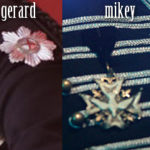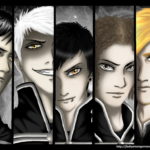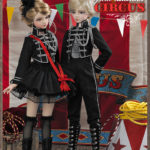Spring delivered an idyllic sunset behind the Lifestyle Communities Pavilion last night, not long before My Chemical Romance took the stage. If the band saw the display, likely the musicians recognized the marked contrast with the music it was about to deliver. The New Jersey group’s catalog, especially the comic opera of its newest album, The Black Parade, is about impulses more likely to emerge after the day’s sunlight has been spent.
That collection was the centerpiece of the previous tour, scheduled for Columbus but canceled because of illness. “We killed The Black Parade (after that),” lead singer Gerard Way said last night. “You didn’t miss much, other than a lot of prancing and some cool explosions.”
Still, the singer — newly returned to his natural brunet — and band performed an extended set of selections from the album. They were the highlights of the evening and spoke best for the potent personal medicine of the band’s material.
Way has said that his songs help him deal with personal demons, no more plain than on the album’s title track, wherein the protagonist leads a parade of damaged, wounded souls.
Last night, the tune not only thundered with the weight of the mission, but its circus-music style provided an absurdly comedic tone. The surreal, jaunty attitude was distilled in Mama, whose darkly comic catharsis was driven by a foundation lifted from Kurt Weill as surely as the Doors covered the Weimar-era German songwriter nearly 40 years ago.
The tunes also found the band sounding the most like Queen, an inspiration permeates the album.
From here: The eight pointed star is in based on the cross of St John. It originated in the Maltese Cross, the emblem of the Knights of Malta, and was used by the Knights of St John of Jerusalem at the time of the crusades.
The Knights of St John of Jerusalem were primarily a charitable, non-military organisation that existed between the eleventh and twelfth centuries. A white or silver cross on a dark background was adopted by these knights or ‘hospitallers’ as they were known, because of their charity toward the sick and poor in setting up hospices and hospitals. Later they did in fact assist the knights of the crusades with their goodwill and also military assistance in an effort to win back the Holy Land.
The Knights of St John eventually moved to the island of Malta and so the symbol became known as the Maltese Cross. The need for an identifiable emblem for the Knights was crucial, because due to the extensive armour which covered their entire body and faces, the Knights were unable to distinguish friend from foe in battle.
During the battles that took place throughout the period of the Holy Wars, one of the Saracens used fire extensively as a weapon. As the Crusaders advanced upon the walls of a city the Saracens resorted to throwing burning naphtha and oil upon the advancing knights. At sea, the Saracens would sail war vessels containing naphtha, rosin and sulphur into the vessels of the knights.
Many Knights of St John were called upon to perform heroic deeds, rescue fellow Knights and extinguish fires. In acknowledgement of their feats of bravery, these Knights wore a Maltese Cross that was decorated and inscribed in acclaim for their actions. It is, perhaps, here that the first association of the cross with firefighters was born.
Wherever the line between myth and truth lies is not exactly known, but it can perhaps be said without contradiction that the Maltese Cross and also any derivatives are regarded as a symbol of protection and courage. It does, perhaps, in simple terms identify with the fact that the firefighter who wears the badge could, and sometimes do, lay down his/her life for others in the same way as the Crusaders sacrificed their lives so many years ago.
From here: The eight-pointed star is the Star of Redemption or Regeneration and represents baptism.








